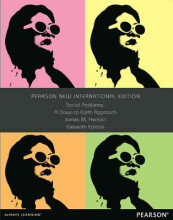Summary: Boek Notes
- This + 400k other summaries
- A unique study and practice tool
- Never study anything twice again
- Get the grades you hope for
- 100% sure, 100% understanding
Read the summary and the most important questions on Boek notes
-
1 CH1 kleiner docu, niet boek. Takenlijst 1
This is a preview. There are 8 more flashcards available for chapter 1
Show more cards here -
What is empiricism (empirical method)
Using evidence from the senses (thermometers, timers, photos) as the basis for conclusions -
2 CH 10 Carr. Takenlijst 1
This is a preview. There are 7 more flashcards available for chapter 2
Show more cards here -
What is participant observation or ethnography
Researches immerse themselves in the lives and social worlds of the people they want to understand. One simply goes where they go, gets to know them over time as best one can. Grasps the native's point of view. It's different than mere description or journalism because in addition to telling a story, an ethnography is creating or testing a social science theory and contributing to the scientific study of society -
What is a systematic observation
A method of observation in which the researcher follows a checklist and timeline for observing phenomena -
Name the steps a researcher takes when conducting an ethnographic field study
- Choose topic and site for
research Negotiating access to the site (gatekeepers: people with the authority to allow outsides in) andforming relationships with subjects (rapport)researcher must spend time in thefield and takefield notes - deciding when and how to
leave thefield - writing up the results of the
study
- Choose topic and site for
-
3 CH 7 Morling. Takenlijst 1
-
In what 2 ways may a sample be biased
- Researchers might study only those they can contact easily. Convenience sampling: using a sample of people who are easy to contact.
- or only those who volunteer to respond. Self-selection: when a sample is known to only contain people who volunteer to participate
-
When external validity (to generalize) is not vital, researchers might be happy with nonprobability sampling techniques. Name them:
Convenience sampling: who is easy to reachPurposive sampling: ifresearchers only want tostudy certain kinds of peopleSnowball sampling: this is avariation of purposive sampling.Participants are asked torecommend a fewacquaintances for thestudy .Quota sampling: similar tostratified random sampling. Theresearcher identifiessubsets of thepopulation of interest and thensets atarget number for eachcategory in thesample -
4 CH 11 Carr. Takenlijst 1
This is a preview. There are 8 more flashcards available for chapter 4
Show more cards here -
How to conduct an interview study, name the steps
- Deciding whom to
interview and how many people tointerview. Decide if you want informants (people with special knowledge about a research question) or respondents (ordinary people you want to learn from) - Writing and
pretesting theinterview schedule Conducting the interviewsRecording andtranscribing the interviewsCoding the responsesAnalyzing and writing the results
- Deciding whom to
-
Name ways to choose a sample for an interview study
Case study logic: think about your interviewees not as a sample of 35 people but as 35 individual cases to be analyzed. Each person is teaching you something, you goal is to understand the case/person in detail, not as a representation of a wider population
Sample for range: to try to maximize interviewees' range of experiences with the phenomena you are investigating. (dit snap ik niet helemaal -
Two elements of focus groups set them apart from in-depth interviews:
- Focus groups are intended to capture interaction. So that the people taking part will ask each other questions. Watching people interact allows the researcher to see whether the participants have stable ideas or if they can be persuaded. In an one on one interview the interviewee might have a very strong opinion, but in a group that might be unstable or change quickly.
- Focus groups then to focus more narrowly than in-depth interviews.
- Focus groups are intended to capture interaction. So that the people taking part will ask each other questions. Watching people interact allows the researcher to see whether the participants have stable ideas or if they can be persuaded. In an one on one interview the interviewee might have a very strong opinion, but in a group that might be unstable or change quickly.
-
6 CH 12 Carr. Takenlijst 1
This is a preview. There are 1 more flashcards available for chapter 6
Show more cards here -
What are materials-based methods
Sociological methods that involve analyzing existing materials rather than interviewing, surveying, or observing people. This can include expert analyses, reports, records, news media.
- Higher grades + faster learning
- Never study anything twice
- 100% sure, 100% understanding





























